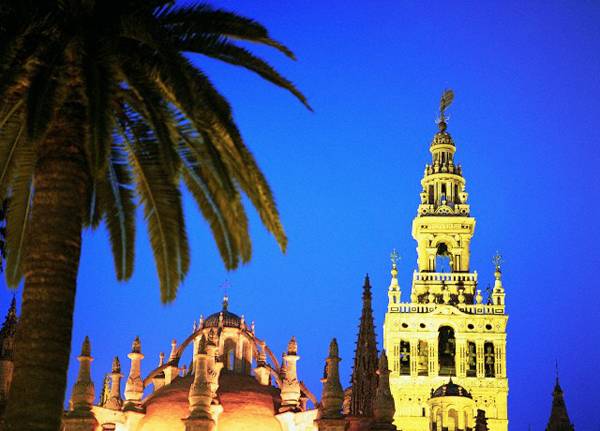
The lofty tower of La Giralda in Seville is a fitting symbol of coexistence. In its arched niches and minarets, the magnificent 104-meter structure combines the Islamic art and the Spanish Renaissance architecture. Famously known today as the Bell Tower of the world’s largest Gothic Church, La Giralda has not completely erased its past. Like the Spanish Ambassador Eduardo Busquets puts it, “The tower is two-thirds Islamic art and one-third Christian”. Its base is a remnant of a 12th century mosque of the Muslim Almohad dynasty, and its top, a grand symbol of a Gothic Cathedral.
Busquets was referring to La Giralda at a special lecture on The Islamic Legacy of Spain hosted by Ambassador Akbar Ahmed, the Ibn Khaldun Chair of Islamic Studies at American University- an event attended by a select group of academicians, diplomats, and interfaith leaders.
As he explored the impact of the medieval period of Muslim Spain, his next reference was the Mezquita catedral de Co’rdoba, or commonly known as the Mosque-Cathedral of Cordoba. A mosque build during the 8th century and an imposing Roman cathedral in the middle of it. This magnificent structure again unites elements of Islamic and Occidental cultures- a grandiose that awed onlookers and inspired poets. One of them being Urdu’s famous poet Allama Iqbal. “In his eloquent poem on the Cordoba mosque, Iqbal links its past to the present, the East to West”, says Ambassador Ahmed, adding that the poem is apt tribute to the merging of the two sides.
[quote]Guru Nanak's two closet companions were a Hindu and a Muslim[/quote]
In Spain, the cities of Seville, Cordoba and Granada are replete with such examples of Islamic and Christian architecture fused together. The silent structures in brick and stone tell tales of conquests, re-conquests, and also embellishing stories of tolerance.
Many of these structures trace their origins to the Golden age of Al-Andalusia in Spain - the oft-quoted period of La Convivencia (the Coexistence) when Muslims, Christians and Jews lived together peacefully.
Ambassador Busquets says it is this history of togetherness that Spain is now vigorously emphasizing. Precisely why the Ministry of Foreign Affairs and Cooperation in 2006 set up Casa Arabe – a body to preserve and promote the country’s Islamic heritage. Busquets, who is the director general of Casa Arabe, says the purpose is to fight prejudices and build stronger social-political ties with the Arab and the Muslim world. If the past has seen the splendor of living together, there is no reason that the present cannot witness that again.
Spain’s history of a co-existence is not a stand-alone case in history. Parallels can be drawn in South Asia, where in the middle of bloody battles and violent conquests, proximity of different faiths stands out. For instance, the Ellora caves in Maharashtra in South of India. The 35 caves carved in the hills between the 5th and11 Century include 12 Buddhist, 14 Hindu and 5 Jain temples- the different faiths merged in the hills.
Another example is the third Mughal Emperor, Akbar, who ruled the Indian sub continent during the 16th century and stamped his era with pluralism. He abolished taxes on non-Muslims and merged the Islamic Persian culture with Indian ideas. Akbar married within faiths - a Hindu Rajput wife, Jodha Bai and a Christian wife, Maria Zorani Begum. In his effort to build pluralistic identity, he even founded a new religion, Din-e-Elhai, which incorporated teachings from Hinduism, Islam, Buddhism and Jainism.
Two generations down the line, Akbar’s enthusiasm was revived by Dara Shikoh, the heir apparent of the Mughal Empire. Shikoh was inspired by Sufi teachings and translated the Hindu scared texts of Upanishads in Persian. Later, his book Majma ul Bahrain (The Confluence of Two Oceans) he explored the similarities between Islamic and Vedantic teachings.
The mingling of faiths extended from emperors to poets and saints like Kabir and Dadu. Both were born in Muslim families, but transcended sectarian boundaries in their teachings, writings and following.
Guru Nanak, the founder of Sikh faith, quoted from extensively from Quran and Vedas. Nanak’s two closet companions were a Hindu and a Muslim.
From mystics to rulers, from poets to powerful men, from Europe to South Asia, the idea of coexistence has lived and flourished in the past. Skeptics may argue that these examples are blurred by bloody battles for power and violent crusades. Maybe, yes. Maybe, no. Maybe, it is how we chose our lessons from history. The present times are once again fraught with battles of “us versus them” and the clashes of faiths. These are the times when Bamiyan Buddhas are reduced to rubble, and when a temple versus a mosque battle claims hundreds of lives. We live in fragile times. So for the sake of our present, and for our future, if history could teach us one important lesson, let that lesson be of tolerance. Let that lesson be of love.
Pawan Bali is an Indian journalist and a filmmaker. She is pursuing a Master’s degree in International Peace and Conflict Studies at American University, Washington D.C.
Twitter: @Bali23
Busquets was referring to La Giralda at a special lecture on The Islamic Legacy of Spain hosted by Ambassador Akbar Ahmed, the Ibn Khaldun Chair of Islamic Studies at American University- an event attended by a select group of academicians, diplomats, and interfaith leaders.
As he explored the impact of the medieval period of Muslim Spain, his next reference was the Mezquita catedral de Co’rdoba, or commonly known as the Mosque-Cathedral of Cordoba. A mosque build during the 8th century and an imposing Roman cathedral in the middle of it. This magnificent structure again unites elements of Islamic and Occidental cultures- a grandiose that awed onlookers and inspired poets. One of them being Urdu’s famous poet Allama Iqbal. “In his eloquent poem on the Cordoba mosque, Iqbal links its past to the present, the East to West”, says Ambassador Ahmed, adding that the poem is apt tribute to the merging of the two sides.
[quote]Guru Nanak's two closet companions were a Hindu and a Muslim[/quote]
In Spain, the cities of Seville, Cordoba and Granada are replete with such examples of Islamic and Christian architecture fused together. The silent structures in brick and stone tell tales of conquests, re-conquests, and also embellishing stories of tolerance.
Many of these structures trace their origins to the Golden age of Al-Andalusia in Spain - the oft-quoted period of La Convivencia (the Coexistence) when Muslims, Christians and Jews lived together peacefully.
Ambassador Busquets says it is this history of togetherness that Spain is now vigorously emphasizing. Precisely why the Ministry of Foreign Affairs and Cooperation in 2006 set up Casa Arabe – a body to preserve and promote the country’s Islamic heritage. Busquets, who is the director general of Casa Arabe, says the purpose is to fight prejudices and build stronger social-political ties with the Arab and the Muslim world. If the past has seen the splendor of living together, there is no reason that the present cannot witness that again.
Spain’s history of a co-existence is not a stand-alone case in history. Parallels can be drawn in South Asia, where in the middle of bloody battles and violent conquests, proximity of different faiths stands out. For instance, the Ellora caves in Maharashtra in South of India. The 35 caves carved in the hills between the 5th and11 Century include 12 Buddhist, 14 Hindu and 5 Jain temples- the different faiths merged in the hills.
Another example is the third Mughal Emperor, Akbar, who ruled the Indian sub continent during the 16th century and stamped his era with pluralism. He abolished taxes on non-Muslims and merged the Islamic Persian culture with Indian ideas. Akbar married within faiths - a Hindu Rajput wife, Jodha Bai and a Christian wife, Maria Zorani Begum. In his effort to build pluralistic identity, he even founded a new religion, Din-e-Elhai, which incorporated teachings from Hinduism, Islam, Buddhism and Jainism.
Two generations down the line, Akbar’s enthusiasm was revived by Dara Shikoh, the heir apparent of the Mughal Empire. Shikoh was inspired by Sufi teachings and translated the Hindu scared texts of Upanishads in Persian. Later, his book Majma ul Bahrain (The Confluence of Two Oceans) he explored the similarities between Islamic and Vedantic teachings.
The mingling of faiths extended from emperors to poets and saints like Kabir and Dadu. Both were born in Muslim families, but transcended sectarian boundaries in their teachings, writings and following.
Guru Nanak, the founder of Sikh faith, quoted from extensively from Quran and Vedas. Nanak’s two closet companions were a Hindu and a Muslim.
From mystics to rulers, from poets to powerful men, from Europe to South Asia, the idea of coexistence has lived and flourished in the past. Skeptics may argue that these examples are blurred by bloody battles for power and violent crusades. Maybe, yes. Maybe, no. Maybe, it is how we chose our lessons from history. The present times are once again fraught with battles of “us versus them” and the clashes of faiths. These are the times when Bamiyan Buddhas are reduced to rubble, and when a temple versus a mosque battle claims hundreds of lives. We live in fragile times. So for the sake of our present, and for our future, if history could teach us one important lesson, let that lesson be of tolerance. Let that lesson be of love.
Pawan Bali is an Indian journalist and a filmmaker. She is pursuing a Master’s degree in International Peace and Conflict Studies at American University, Washington D.C.
Twitter: @Bali23

